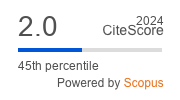Research in action to push the boundaries of scientific research and technological development
DOI:
https://doi.org/10.23726/cij.2024.1530Keywords:
CERN IdeaSquare, innovation, CERN, CIJAbstract
Lying in the space of human curiosity, this issue of CIJ experiments with the boundaries of scientific exploration to foster technological development. To cultivate experimental innovation, it is imperative to translate research into tangible action, explore multifaceted problems, offer support for implementation, and effectuate meaningful changes.
References
VV, AA. (2024). Coffee, theorems and...innovation. CERN IdeaSquare Journal of Experimental Innovation, 8(1), 49– 53. https://doi.org/10.23726/cij.2024.1507
CERN, & Leveratto, L. (2023). IdeaSquare progress report 2021-2023. CERN. https://doi.org/10.17181/CERN.X18C.EOY0
Dajani, K., & Šaranko, J. (2024). Mind the Gap: Addressing Unconscious Bias in Multidisciplinary Team Ideation. CERN IdeaSquare Journal of Experimental Innovation, 8(1): 43-48. https://doi.org/10.23726/cij.2024.1406
Feenstra, M., Hopp, C., Pruschak, G., & Werker, C. (2024). Are Open Innovation and Entrepreneurial Intentions complements or substitutes for the successful commercialization of academic Breakthrough Technologies? CERN IdeaSquare Journal of Experimental Innovation, 8(1): 9-19. https://doi.org/10.23726/cij.2024.1506
Fisher, A., Blankesteijn, M. L., Harms, R., & van Muilwijk- Koezen, J. (2024). Entrepreneurial Self-Efficacy of Scientists: A qualitative study on ATTRACT Phase 2 R&D&I Ventures. CERN IdeaSquare Journal of Experimental Innovation, 8(1): 20-25. https://doi.org/10.23726/cij.2024.1508
Florio, M., & Castelnovo, P. (2023). Quasi-experiments to estimate the economic impact of research infrastructures. CERN IdeaSquare Journal of Experimental Innovation, 7(3): 5-7. https://doi.org/10.23726/cij.2023.1492
Guertler, M., & Sick, N. (2024) Action research: Combining research and problem solving for socio-technical engineering and innovation management research. CERN IdeaSquare Journal of Experimental Innovation, 8(1), 5–8. https://doi.org/10.23726/cij.2024.1509
Pennings, R., Tello, P., & Nordberg, M. (2018). A strategic proposal for boosting breakthrough co-innovation on detection and imaging technologies in Europe-preparing the scene in phase 1. https://attract-eu.com/wp-content/uploads/2021/04/A TTRACT-1.pdf
Ranti, C. D., Arumsari, G. M., & Lee, H. (2024). Exploring student and teacher perspectives on education with technological advancement in Indonesia through Design Thinking in response to COVID-19. CERN IdeaSquare Journal of Experimental Innovation, 8(1): 36-42. https://doi.org/10.23726/cij.2024.1475
Romme, A. G. L. (2023). Design science as experimental methodology in innovation and entrepreneurship research: A primer. CERN IdeaSquare Journal of Experimental Innovation, 7(2): 4-7. https://doi.org/10.23726/cij.2022.1427
Sierra, M., & Di Stasi, M. (2024). Multiplicity and diversity: The key for innovation. CERN IdeaSquare Journal of Experimental Innovation, 8(1):26-35. https://doi.org/10.23726/cij.2024.1476
Wareham, J., Pujol Priego, L., Romasanta, A. K., Mathiassen, T. W., Nordberg, M., & Tello, P. G. (2022). Systematizing serendipity for big science infrastructures: The ATTRACT project. Technovation, 116, 102374. https://doi.org/10.1016/j.technovation.2021.102374
Downloads
Published
How to Cite
License
Copyright (c) 2024 Matteo Vignoli, Jonathan Wareham

This work is licensed under a Creative Commons Attribution 4.0 International License.
Authors who publish with this journal agree to the following terms:
- Authors retain copyright and grant the journal right of first publication with the work simultaneously licensed under a Creative Commons Attribution License that allows others to share the work with an acknowledgement of the work's authorship and initial publication in this journal.
- Authors are able to enter into separate, additional contractual arrangements for the non-exclusive distribution of the journal's published version of the work (e.g., post it to an institutional repository or publish it in a book), with an acknowledgement of its initial publication in this journal.
- Authors are permitted and encouraged to post their work online (e.g., in institutional repositories or on their website) prior to and during the submission process, as it can lead to productive exchanges, as well as earlier and greater citation of published work (See The Effect of Open Access).


